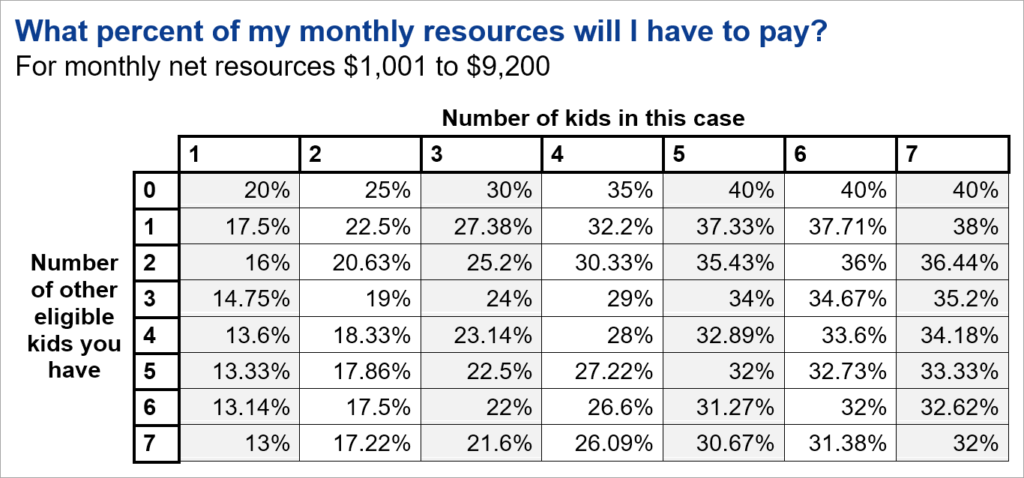Calculating child support can be a complex process, influenced by various factors, including income, the number of children, and state laws. For parents who make a weekly income of $1,000, understanding how much they may owe in child support is crucial for effective financial planning. This article will provide a detailed breakdown of child support calculations based on income, relevant laws, and statistics to help you navigate this important financial responsibility.
If I make $1,000 a week, how much child support do I pay?
The amount of child support you may be required to pay typically depends on state guidelines. Generally, if you make $1,000 per week, you could expect to pay around 17% to 25% of your gross income for one child, which amounts to approximately $170 to $250 weekly. For two children, the percentage may increase, ranging from 25% to 30%, translating to about $250 to $300 per week.
Understanding Child Support Guidelines
Child support is essential for the well-being of children, covering their basic needs such as food, clothing, education, and healthcare. Each state in the U.S. has specific guidelines designed to calculate child support obligations based on the parents’ income and other relevant factors.
- Income Consideration: States typically require both parents to disclose their income, including wages, bonuses, and other forms of compensation. For this scenario, we focus on a weekly income of $1,000.
- Basic Support Formula: Most states use an income-based formula that sets a percentage of the non-custodial parent’s gross income to determine the support amount.
- Additional Factors: Other considerations may include the number of children, health insurance costs, and extraordinary expenses such as childcare or medical bills.
Child Support Percentage by State
The percentage of income allocated for child support varies from state to state. Below is a table summarizing the typical child support percentages for one child and two children in various states.
| State | 1 Child (%) | 2 Children (%) |
|---|---|---|
| California | 20% | 25% |
| New York | 17% | 25% |
| Texas | 20% | 25% |
| Florida | 18% | 30% |
| Illinois | 20% | 25% |
| Pennsylvania | 20% | 25% |
How to Calculate Child Support Payments
To determine child support payments from a weekly income of $1,000, use the following steps:
- Identify Your Income: Calculate your gross income. In this example, it is $1,000 per week.
- Determine the State Percentage: Check your state’s guidelines to find the applicable percentage for one or two children.
- Calculate the Child Support Amount: Multiply your weekly income by the percentage indicated for child support.
Sample Calculation
Using California’s guideline for one child, if you make $1,000 per week:
- Calculation: $1,000 x 20% = $200 weekly.
For two children in Florida:
- Calculation: $1,000 x 30% = $300 weekly.
Modifications and Adjustments
Situations can change, and child support payments may need adjustments. Common factors that can lead to modifications include:
- Change in Income: If a parent’s income significantly increases or decreases, they may seek to modify the support amount.
- Change in Custody: If custody arrangements change, the existing support agreement may require a reassessment.
- Additional Expenses: New expenses, such as medical or educational costs, can also prompt a review of child support obligations.
Charting the Trends in Child Support Payments
Recent statistics indicate a trend in child support payments that reflect economic changes and parenting dynamics. The following table shows the average weekly child support payments across various income brackets.
| Income Bracket | Average Weekly Payment |
|---|---|
| $500 – $1,000 | $150 – $250 |
| $1,001 – $2,000 | $250 – $400 |
| $2,001 – $3,000 | $400 – $600 |
| $3,001+ | $600+ |
Challenges in Child Support
Despite the guidelines, many parents face challenges related to child support, including:
- Non-Payment Issues: Some non-custodial parents struggle to meet their child support obligations, leading to enforcement actions.
- Complex Calculations: Understanding the intricate formulas used by different states can lead to confusion and disputes.
- Low Income Situations: Parents earning lower incomes may feel overwhelmed by their obligations, leading to requests for modifications.
Resources for Parents
Various resources can assist parents with child support calculations and legal advice:
- State Child Support Agencies: They provide guidelines and assistance for understanding local laws and calculations.
- Legal Aid: Organizations that offer legal assistance can help parents navigate the complexities of child support.
- Online Calculators: Many websites offer child support calculators based on state laws, making it easier for parents to estimate their obligations.
Final Thoughts
Understanding child support obligations for a weekly income of $1,000 involves navigating through state-specific guidelines that dictate percentages based on income and the number of children. By carefully analyzing your situation, calculating potential payments, and keeping abreast of changes in your circumstances, you can ensure that you meet your responsibilities while also safeguarding your financial well-being.
Child support plays a significant role in ensuring children’s needs are met, and it is crucial for both custodial and non-custodial parents to stay informed about their obligations and rights.

